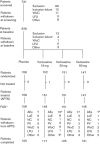Efficacy and safety of vortioxetine (Lu AA21004), 15 and 20 mg/day: a randomized, double-blind, placebo-controlled, duloxetine-referenced study in the acute treatment of adult patients with major depressive disorder
- PMID: 24257717
- PMCID: PMC3979887
- DOI: 10.1097/YIC.0000000000000018
Efficacy and safety of vortioxetine (Lu AA21004), 15 and 20 mg/day: a randomized, double-blind, placebo-controlled, duloxetine-referenced study in the acute treatment of adult patients with major depressive disorder
Abstract
This study assessed the efficacy, tolerability and safety of vortioxetine versus placebo in adults with recurrent major depressive disorder. This double-blind, randomized, placebo-controlled study included 608 patients [Montgomery-Åsberg Depression Rating Scale (MADRS) total score ≥ 26 and Clinical Global Impression - Severity score ≥ 4]. Patients were randomly assigned (1 : 1 : 1 : 1) to vortioxetine 15 mg/day, vortioxetine 20 mg/day, duloxetine 60 mg/day or placebo. The primary efficacy endpoint was change from baseline in MADRS total score at week 8 (mixed model for repeated measurements). Key secondary endpoints were: MADRS responders; Clinical Global Impression - Improvement scale score; MADRS total score in patients with baseline Hamilton Anxiety Rating Scale ≥ 20; remission (MADRS ≤ 10); and Sheehan Disability Scale total score at week 8. On the primary efficacy endpoint, both vortioxetine doses were statistically significantly superior to placebo, with a mean difference to placebo (n = 158) of -5.5 (vortioxetine 15 mg, P < 0.0001, n = 149) and -7.1 MADRS points (vortioxetine 20 mg, P < 0.0001, n = 151). Duloxetine (n = 146) separated from placebo, thus validating the study. In all key secondary analyses, both vortioxetine doses were statistically significantly superior to placebo. Vortioxetine treatment was well tolerated; common adverse events (incidence ≥ 5%) were nausea, headache, diarrhea, dry mouth and dizziness. No clinically relevant changes were seen in clinical safety laboratory values, weight, ECG or vital signs parameters. Vortioxetine was efficacious and well tolerated in the treatment of patients with major depressive disorder.
Trial registration: ClinicalTrials.gov NCT01140906.
Figures




Similar articles
-
A randomized, double-blind, duloxetine-referenced study comparing efficacy and tolerability of 2 fixed doses of vortioxetine in the acute treatment of adults with MDD.Psychopharmacology (Berl). 2015 Jun;232(12):2061-70. doi: 10.1007/s00213-014-3839-0. Epub 2015 Jan 11. Psychopharmacology (Berl). 2015. PMID: 25575488 Free PMC article. Clinical Trial.
-
A randomised, double-blind, placebo controlled, duloxetine-referenced, fixed-dose study of three dosages of Lu AA21004 in acute treatment of major depressive disorder (MDD).Eur Neuropsychopharmacol. 2012 Jul;22(7):482-91. doi: 10.1016/j.euroneuro.2011.11.008. Epub 2011 Dec 30. Eur Neuropsychopharmacol. 2012. PMID: 22209361 Clinical Trial.
-
A randomised, double-blind study in adults with major depressive disorder with an inadequate response to a single course of selective serotonin reuptake inhibitor or serotonin-noradrenaline reuptake inhibitor treatment switched to vortioxetine or agomelatine.Hum Psychopharmacol. 2014 Sep;29(5):470-82. doi: 10.1002/hup.2424. Hum Psychopharmacol. 2014. PMID: 25087600 Free PMC article. Clinical Trial.
-
A meta-analysis of randomized, placebo-controlled trials of vortioxetine for the treatment of major depressive disorder in adults.Eur Neuropsychopharmacol. 2016 Jun;26(6):979-93. doi: 10.1016/j.euroneuro.2016.03.007. Epub 2016 Mar 25. Eur Neuropsychopharmacol. 2016. PMID: 27139079 Review.
-
Vortioxetine versus Duloxetine in the Treatment of Patients with Major Depressive Disorder: A Meta-Analysis of Randomized Controlled Trials.Clin Drug Investig. 2016 Jul;36(7):509-17. doi: 10.1007/s40261-016-0396-9. Clin Drug Investig. 2016. PMID: 27067232 Review.
Cited by
-
Efficacy, Safety, and Tolerability of Ansofaxine (LY03005) Extended-Release Tablet for Major Depressive Disorder: A Randomized, Double-Blind, Placebo-Controlled, Dose-Finding, Phase 2 Clinical Trial.Int J Neuropsychopharmacol. 2022 Mar 17;25(3):252-260. doi: 10.1093/ijnp/pyab074. Int J Neuropsychopharmacol. 2022. PMID: 34747448 Free PMC article. Clinical Trial.
-
Vortioxetine reduces BOLD signal during performance of the N-back working memory task: a randomised neuroimaging trial in remitted depressed patients and healthy controls.Mol Psychiatry. 2018 May;23(5):1127-1133. doi: 10.1038/mp.2017.104. Epub 2017 May 23. Mol Psychiatry. 2018. PMID: 28533517 Free PMC article. Clinical Trial.
-
Efficacy and Safety of Toludesvenlafaxine Hydrochloride Sustained-Release Tablets in Depression With Anhedonia: A Single-Arm, Multicenter Clinical Study.Depress Anxiety. 2025 May 5;2025:6130764. doi: 10.1155/da/6130764. eCollection 2025. Depress Anxiety. 2025. PMID: 40365616 Free PMC article.
-
Vortioxetine (brintellix): a new serotonergic antidepressant.P T. 2015 Jan;40(1):36-40. P T. 2015. PMID: 25628505 Free PMC article.
-
A brief history of the development of antidepressant drugs: from monoamines to glutamate.Exp Clin Psychopharmacol. 2015 Feb;23(1):1-21. doi: 10.1037/a0038550. Exp Clin Psychopharmacol. 2015. PMID: 25643025 Free PMC article. Review.
References
-
- American Psychiatric Association (APA) Diagnostic and statistical manual of mental disorders, text revision (DSM-IV-TR) 2000:4th ed.Washington DC:American Psychiatric Association
-
- Areberg J, Chen G, Naik H, Pedersen KB, Vakilynejad M.A population pharmacokinetic meta-analysis of vortioxetine (Lu AA21004) in healthy subjects.Int J Psychiatry Clin Pract 2012a;16Suppl 115
-
- Areberg J, Luntang-Jensen M, Søgaard B, Nilausen DO.Occupancy of the serotonin transporter after administration of Lu AA21004 and its relation to plasma concentration in healthy subjects.Basic Clin Pharmacol Toxicol 2012b;110:401–404 - PubMed
-
- Baldwin DS.Sexual dysfunction associated with antidepressant drugs.Expert Opin Drug Saf 2004;3:457–470 - PubMed
Publication types
MeSH terms
Substances
Associated data
LinkOut - more resources
Full Text Sources
Other Literature Sources
Medical
Miscellaneous

